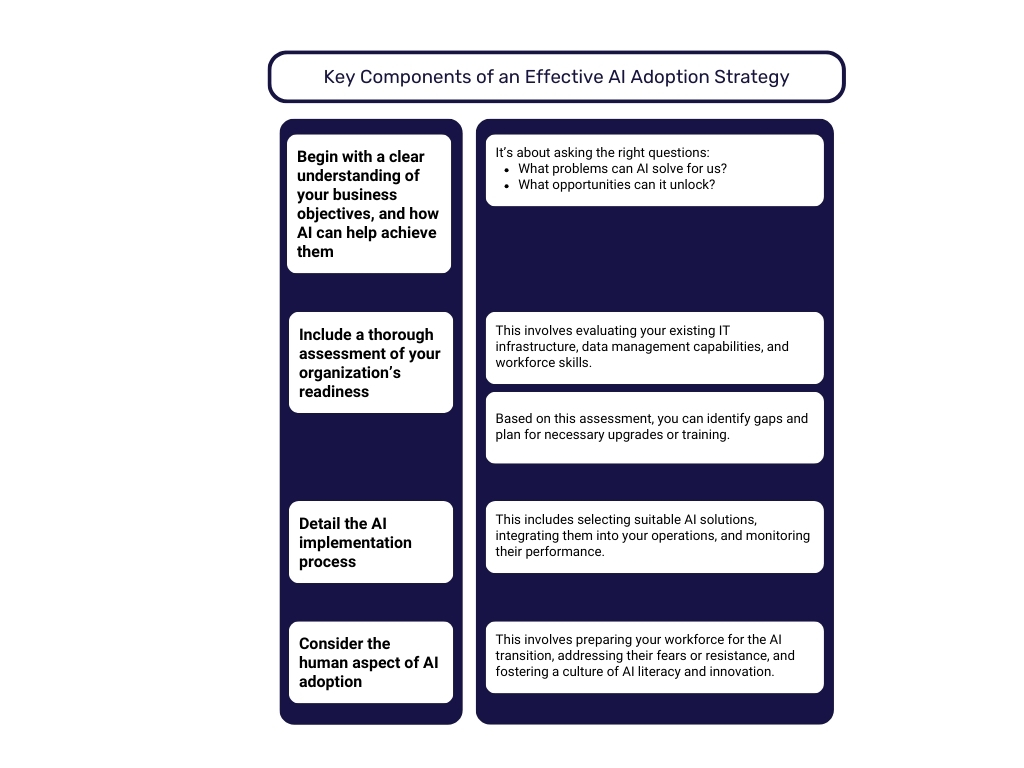
Developing a Profound AI Adoption Strategy
Author: Kysha Praciak
· 5 mins readIntroduction
Artificial Intelligence (AI) is no longer just a concept in futuristic movies or an abstract idea discussed in tech conferences. It’s here, and it’s transforming the way we live and work in profound ways. As such, businesses across sectors are recognizing the need to adopt AI to stay competitive and relevant in the digital era. This brings us to the concept of an AI adoption strategy, a framework that guides organizations on how to integrate AI into their operations effectively.
An AI adoption strategy is not merely about using AI tools or technologies. It’s about understanding how AI can add value to your business, identifying the right AI solutions for your specific needs, and integrating them seamlessly into your existing processes. It’s also about preparing your workforce for the AI transition and constantly monitoring and tweaking your strategy based on outcomes.
This article aims to provide insights on how to develop an AI adoption strategy that delivers results. So whether you’re an AI newbie or a seasoned tech professional, I hope you’ll find this article helpful.
Understanding AI and its Potential Impact
AI, at its core, is about creating machines that can think and learn like humans. It encompasses a wide range of technologies like machine learning, natural language processing, and robotics. What makes AI truly transformative is its ability to process vast amounts of data, identify patterns, and make predictions or decisions with minimal human intervention.
AI holds immense potential to transform businesses. It can automate routine tasks, enhance decision-making, and deliver personalized customer experiences. For instance, AI can streamline supply chain management by predicting demand trends or identifying potential bottlenecks. In customer service, AI chatbots can handle routine queries, freeing up human agents to focus on more complex issues.
However, leveraging AI’s full potential requires more than just implementing AI tools. It entails a strategic, organization-wide approach, which is where an AI adoption strategy comes in. Without a well-defined strategy, businesses risk investing in AI solutions that may not align with their goals or deliver the desired results.
The Need for an AI Adoption Strategy
Developing an AI adoption strategy is not a luxury but a necessity for businesses today. This necessity arises from the complex, transformative nature of AI and the challenges it poses.
- Firstly, AI is not a one-size-fits-all solution – it’s a diverse field with a multitude of technologies and applications.
- Identifying the right AI solutions that align with your business objectives and operational needs is crucial.
- A haphazard approach can lead to wastage of resources and sub-par results.
- Secondly, AI integration can be a complex process, requiring changes at various levels – from IT infrastructure to business processes to employee skills.
- An AI adoption strategy provides a roadmap for this change process, minimizing disruption and resistance.
- Lastly, AI can pose ethical and legal challenges, such as data privacy concerns or bias in AI algorithms.
- A sound AI adoption strategy should address these concerns proactively, ensuring responsible and compliant use of AI.

Steps to Develop Your AI Adoption Strategy
Developing an AI adoption strategy can be a complex process, but it can be broken down into manageable steps:
- Define your AI vision and goals – this involves understanding your business needs and identifying how AI can add value.
- Assess your organization’s AI readiness – this entails evaluating your IT infrastructure, data management capabilities, and workforce skills and identifying areas for improvement.
- Select suitable AI solutions – this involves researching different AI technologies and vendors, considering factors such as functionality, scalability, cost, and vendor support.
- Plan for AI integration – this involves designing new workflows, setting up necessary IT support, and planning for employee training.
- Implement, monitor, and refine your AI adoption strategy – this involves deploying the selected AI solutions, tracking their performance, and making necessary adjustments based on outcomes.
Challenges in Implementing an AI Adoption Strategy
Despite its potential benefits, implementing an AI adoption strategy can pose several challenges, these include:
- The lack of understanding or skills related to AI – this can lead to resistance among employees or misalignment between AI initiatives and business goals.
- The high cost and complexity of AI implementation – this includes the cost of AI tools, upgrades to IT infrastructure, and employee training.
- Data management can also be a challenge, given the large volumes of data that AI systems need to operate effectively – this includes issues related to data quality, privacy, and security.
- Ethical and legal challenges can arise, such as bias in AI algorithms or non-compliance with data protection laws.
How to Overcome These Challenges
Overcoming the challenges of AI adoption requires a strategic, proactive approach:
- To address the skills gap, organizations can invest in AI training for their employees – this can include workshops, online courses, or partnerships with AI training providers.
- To manage the cost and complexity of AI implementation, organizations can start with small, pilot projects before scaling up. They can also consider partnering with AI vendors or consultants for technical support.
- Data management challenges can be addressed by investing in robust data management systems and practices – this includes ensuring data quality, implementing strong data security measures, and complying with data protection laws.
- Ethical and legal challenges can be mitigated by developing clear policies on responsible AI use and staying updated on relevant laws and regulations.

The Future of AI Adoption
Looking ahead, the future of AI adoption is promising. As AI technologies continue to evolve and become more accessible, more and more businesses are likely to embrace AI.
However, successful AI adoption in the future will require a strategic, holistic approach. It will not just be about using AI tools but about integrating AI into the business strategy and culture. It will also require addressing the ethical and societal implications of AI, such as job displacement or data privacy concerns.
In this future, an AI adoption strategy will be a critical tool for businesses to leverage AI effectively and responsibly.
Conclusion
In conclusion, developing an AI adoption strategy is a complex but essential task for businesses in the digital age. It’s not just about using AI tools but about understanding how AI can add value to your business and integrating it effectively into your operations.
While there can be challenges in AI adoption, they can be overcome with a strategic, proactive approach. Various tools and resources are available to aid in this journey.
As we look to the future, an AI adoption strategy will be a key instrument for businesses to leverage AI’s transformative potential while navigating its challenges. So, let’s embrace this journey with an open mind and a strategic plan.
Looking for Expert IT Solutions?
Stay ahead of tech challenges with expert insights delivered straight to your inbox. From solving network issues to enhancing cybersecurity and streamlining software integration, our newsletter offers practical advice and the latest IT trends. Sign up today and let us help you make technology work seamlessly for your business!




Share